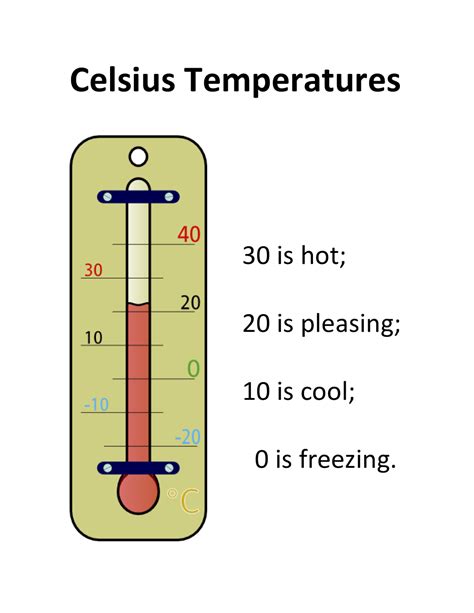**Celsius to Fahrenheit: A Comprehensive Guide for Temperature Conversion**
Understanding the Celsius and Fahrenheit Scales
Celsius and Fahrenheit are two temperature scales commonly used around the world. The Celsius scale, denoted by °C, is based on the freezing point of water being 0°C and the boiling point being 100°C. The Fahrenheit scale, denoted by °F, defines the freezing point of water as 32°F and the boiling point as 212°F.
Converting Between Celsius and Fahrenheit
Converting temperatures between Celsius and Fahrenheit can be confusing, but it's a simple process once you know the formula:
°F = (°C × 9/5) + 32
°C = (°F - 32) × 5/9
For example, to convert 60°C to Fahrenheit:
°F = (60°C × 9/5) + 32
= (108) + 32
= **140°F**
Table for Converting Common Temperatures
The following table provides a quick reference for converting common temperatures between Celsius and Fahrenheit:

| Celsius |
Fahrenheit |
| 0°C |
32°F |
| 10°C |
50°F |
| 20°C |
68°F |
| 30°C |
86°F |
| 40°C |
104°F |
| 50°C |
122°F |
| 60°C |
140°F |
| 70°C |
158°F |
| 80°C |
176°F |
| 90°C |
194°F |
| 100°C |
212°F |
Why Celsius and Fahrenheit Matter
The temperature scale used in different countries can impact everyday life and scientific research.

-
Weather forecasting: Most countries use Celsius for weather forecasts, while the United States and a few others use Fahrenheit.
-
Cooking: Recipes often provide temperatures in Celsius, so converting to Fahrenheit can be important for accurate cooking.
-
Medical field: Body temperature is typically measured in Celsius, but some medical devices use Fahrenheit.
-
Scientific research: Temperature is a crucial factor in many scientific experiments, and consistency between Celsius and Fahrenheit is essential for data analysis.
Benefits of Converting Temperatures
Converting temperatures between Celsius and Fahrenheit allows for easier:
-
Communication: Understanding both scales facilitates communication with people from different regions.
-
Travel: Knowing the local temperature scale can help travelers plan appropriate clothing and activities.
-
Research: Conversion between scales enables researchers to compare data and collaborate internationally.
-
Safety: Accurately converting temperatures is vital for safety in industries like cooking, heating, and cooling.
Humorous Stories About Celsius and Fahrenheit
Story 1: The American Tourist in Europe
An American tourist visited Europe and asked for directions to a nearby park. The local gave directions using Celsius, which the tourist didn't understand. After a hilarious misunderstanding, the tourist finally reached the park - which was a frozen lake at -10°C (14°F)!

Lesson learned: Always ask for clarification on temperature scales when traveling.
Story 2: The British Baker
A British baker preparing a cake misread the recipe, which called for 180°C (356°F). The baker used Fahrenheit and set the oven to 180°F (82°C), resulting in an undercooked cake.
Lesson learned: Double-check temperature scales before baking to avoid culinary disasters.
Story 3: The Canadian Sweater
A Canadian living in Florida bought a sweater labeled "60°F." Thinking it was 60°C, they wore it outside on a warm day and nearly fainted from heatstroke.
Lesson learned: Be aware of the temperature scale used in your location before purchasing clothing.

Tips and Tricks for Converting Temperatures
-
Use a conversion app: Smartphone apps can instantly convert temperatures between Celsius and Fahrenheit.
-
Remember the "32°" rule: When converting from Fahrenheit to Celsius, subtract 32 first.
-
Use multiplication tables: Multiply the Celsius temperature by 9/5 for Fahrenheit conversion, or vice versa.
-
Visualize the scales: Imagine a Celsius thermometer from -50°C to 50°C, overlapping a Fahrenheit thermometer from -67°F to 122°F. This helps visualize the relationship between the scales.
Step-by-Step Approach to Converting Temperatures
- Identify the starting temperature.
- Determine if you need to convert from Celsius to Fahrenheit or vice versa.
-
Use the appropriate formula:
- °F = (°C × 9/5) + 32
- °C = (°F - 32) × 5/9
- Calculate the converted temperature.
- Confirm the accuracy of your conversion.
Additional Resources
Conclusion
Converting temperatures between Celsius and Fahrenheit is an important skill for communication, travel, scientific research, and everyday tasks. By understanding the formulas, using conversion apps, and employing the tips and tricks outlined above, you can confidently master the art of temperature conversion. Remember to have a sense of humor when things get "Fahrenheit-Celsius" confusing!
